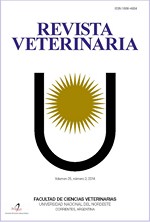Diversidad genética molecular y relación entre ovejas de razas autóctonas de Pakistan basada en locus microsatelitales nucleares
DOI:
https://doi.org/10.30972/vet.3013906Palabras clave:
Oveja, buchi, hashtnagri, diversidad genética, marcadores microsatelitales, PakistánResumen
En Pakistán los recursos genéticos ovinos son abundantes, disponiéndose de varias diferentes castas extendidas en todo el país. No obstante, la diversidad molecular de las razas de ovejas es poco conocida en la región. Por ello, en el presente estudio se investigaron 16 marcadores microsatelitales de las razas indígenas Buchi y Hashtnagri, en las provincias de Pendjab y Balochistan respectivamente. Para indagar la diversidad genética se obtuvieron muestras de sangre de 25 animales de cada raza. El promedio del número de alelos en Buchi y Hashtnagri fue de 3,375±1,455 y 3,50±1,591 respectivamente. Los promedios de heterocigosis registradas fueron de 0,878±0,204 para la raza Buchi y 0,885±0,218 para Hashtnagri. Los índices de Shannon fueron 1,032±0,371 para Buchi y 1,070±0,412 para Hashtnagri, respectivamente. La estimación de los coeficientes de endogamia (FIS y FIT) mostró valores negativos, en tanto que el flujo genético (migración) fue de 10,09 y el promedio de la diferencia poblacional (FST) resultó de 2,4%. En ambas razas, el índice de información polimórfica fue 0,56, indicando el valor del marcador del tablero. Entre las ovejas Buchi y Hashtnagri, la distancia genética estándar de Nei (Ds) fue 0,0218. Según estos resultados, ambas razas mostraron considerable diversidad genética. Los datos obtenidos permiten vislumbrar una promisoria mejoría en el área de la conservación y en el diseño de las estrategias para la cría de ovejas en el futuro cercano.
Descargas
Descargas
Publicado
Cómo citar
Número
Sección
Licencia
Derechos de autor 2019 T Hussain, M M. Musthafa, M E. Babar, M Shaheen, F M. Marikar

Esta obra está bajo una licencia internacional Creative Commons Atribución-NoComercial 4.0.
Política de acceso abierto
Esta revista proporciona un acceso abierto inmediato a su contenido, basado en el principio de que ofrecer al público un acceso libre a las investigaciones ayuda a un mayor intercambio global de conocimiento. La publicación por parte de terceros será autorizada por Revista Veterinaria toda vez que se la reconozca debidamente y en forma explícita como lugar de publicación del original.
Esta obra está bajo una licencia de Creative Commons Reconocimiento-NoComercial 4.0 Internacional (CC BY-NC 4.0)










.jpg)
.jpg)



